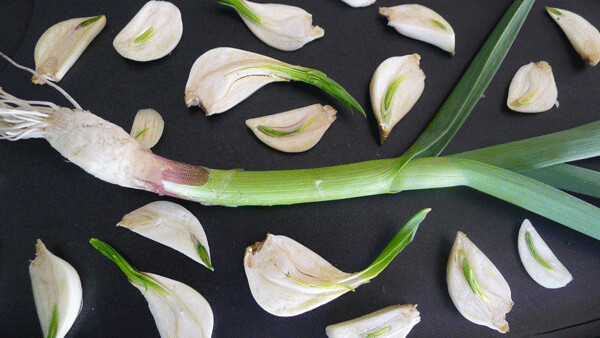News & Articles
Browse all content by date.

This time of year, the biology of garlic becomes impossible to ignore. A green shoot appears inside every clove, in every head of garlic in the Northern Hemisphere. It’s a reminder that garlic isn’t just some lily white bulb that exists solely for your eating pleasure, but is a complete plant, with goals and habits, not to mention a set of roots, a stem, and leaves.
The flat scab at the bottom of a garlic clove is technically the stem of the plant. On one edge of the stem, a tight cluster of tiny root bulbs waits for a signal to grow. The white, fleshy part of the clove--the part we typically eat--is a modified leaf that functions as a food storage organ. Inside that white starchy leaf, this time of year, a green spear forms in the middle, consisting of about ten tightly wrapped leaves.
Many cooks will pry out this offending growth and cast it aside. They are wasting time and garlic, in my opinion, because that green core is the freshest, most nutritious part of the plant. It has a reputation for being bitter, but I don’t taste that. I taste vibrant green, with garlicky zing.
With the appearance of the shoot, the clove around it begins to soften, but it remains usable as long as the clove doesn’t turn yellow. Eventually it will shrivel, and be shrugged off like a snake skin by the growing shoot inside. Until that time, it’s all edible. It’s all garlic.
I serve the sprouted cloves sliced lengthwise to display their insides, wagging the internal parts in your face like a jazz musician hitting a funky note extra hard, so everyone knows he meant it.
Pan-fried, in butter and olive oil, these beautiful samples of garlic anatomy become decadently sweet without losing their savory garlic gravitas. I add these nuggets of flavor to pizza, omelets, sandwiches and soups, scattering them across my meals like fistfuls of pine nuts atop a bowl of pasta.
Aspiring gardeners will sometimes be taken by a sprouted clove’s obvious desire to grow, and plant it in the ground, or on the windowsill. This act will be rewarded with lots of greenery, but no bulb.
If the clove currently sprouting in your pantry were planted last fall, that would be a different story. Today it would be tall and robust, with fat cloves forming on the below-ground stem.
That is the case in my garden looks like, which is one of the reasons I have no interest in planting sprouted cloves. My interest is in eating those sprouted cloves, enjoying their quirky beauty and enduring flavor, as if I’ve been waiting all year for sprouted garlic season. I advise you to do the same.
And, if growing garlic is something you truly want to take on--and you definitely should--now is a perfect time to get started. Although it’s too early to start digging and planting, it’s great for scheming and planning. September sounds a long way off, but we all know it will pounce on summer’s bubble like a cat. We might as well be ready.
Aspiring garlic growers must identify a spot that will be vacant and ready to go in October, by which time the garlic should be planted. Another off-season task is to identify which kind of garlic to plant. Check the farmers market for examples of varieties that grow in your area, and perhaps purchase your seed garlic locally. The garlic for sale in August should be fully cured and ready for planting, but ask the farmer, just in case. If you have any doubts, ask the farmer, who will most likely be flattered by your interest in growing their garlic.
In the meantime you, the aspiring garlic farmer, can practice cooking the living plant known as sprouted garlic.
Here’s a recipe for sprouted garlic in oyster sauce to get you started. It features garlic as vegetable, as eating it is like being a garlic shark swimming through a school of sweet and savory garlic fishes.
When the scapes come, next month, and the new garlic a month later, the same recipe will also work for those lovely parts of the garlic plant. Because one of the most important facts of garlic is it was created to be flavored by oyster sauce.

Sprouted Garlic in Oyster Sauce
Although it contains no added sugar, this recipe tastes sweetened thanks to all that sweet, not bitter, beautiful sprouted garlic. The dish can absorb most any other vegetable or protein you might want to add.
2 tablespoons olive oil
1 tablespoon butter
½ teaspoon toasted sesame oil
two heads of sprouted garlic
½ x ½ inch cube of fresh ginger, peeled and minced
2 tablespoons of oyster sauce
1 pod of star anise
¼ teaspoon black pepper
1 tablespoon soy sauce
½ cup water or stock
Trim the bottoms of the cloves if you wish. Slice each sprouted clove lengthwise, as thinly as you safely can. Fry the garlic halves slowly in the butter and oils on medium/low, along with any extra proteins and veggies you may be using.
When the garlic slices are lightly browned all around and thoroughly sweet, add the oyster sauce, black pepper, soy sauce, anise and stock. Stir well, and cook slowly until the sauce thickens to your liking, about ten minutes. Remove the anise pod, and serve, perhaps on rice. You could garnish it with a green herb, but it’s hardly necessary. Sprouted garlic is a self-garnishing vegetable.
| Tweet |


